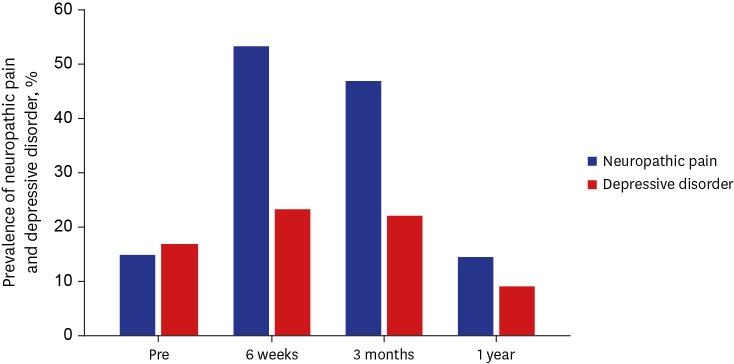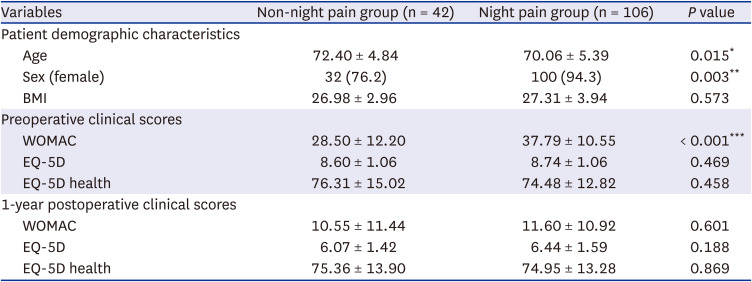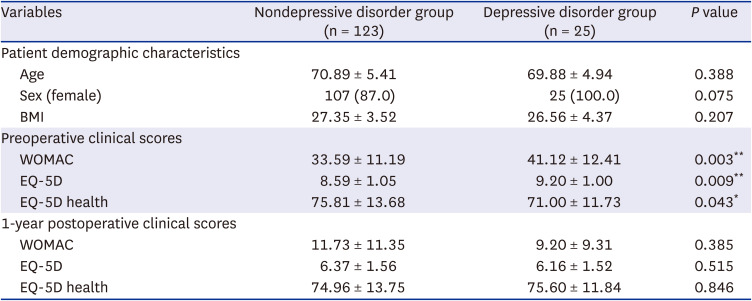1. Callahan CM, Drake BG, Heck DA, Dittus RS. Patient outcomes following tricompartmental total knee replacement. A meta-analysis. JAMA. 1994; 271(17):1349–1357. PMID:
8158821.
2. Heck DA, Robinson RL, Partridge CM, Lubitz RM, Freund DA. Patient outcomes after knee replacement. Clin Orthop Relat Res. 1998; 356:93–110.
3. Wylde V, Learmonth I, Potter A, Bettinson K, Lingard E. Patient-reported outcomes after fixed- versus mobile-bearing total knee replacement: a multi-centre randomised controlled trial using the Kinemax total knee replacement. J Bone Joint Surg Br. 2008; 90(9):1172–1179. PMID:
18757956.
4. Noble PC, Conditt MA, Cook KF, Mathis KB. The John Insall Award: patient expectations affect satisfaction with total knee arthroplasty. Clin Orthop Relat Res. 2006; 452:35–43. PMID:
16967035.
5. Bourne RB, Chesworth BM, Davis AM, Mahomed NN, Charron KD. Patient satisfaction after total knee arthroplasty: who is satisfied and who is not? Clin Orthop Relat Res. 2010; 468(1):57–63. PMID:
19844772.
6. Ranawat CS, White PB, West S, Ranawat AS. Clinical and radiographic results of attune and PFC sigma knee designs at 2-year follow-up: a prospective matched-pair analysis. J Arthroplasty. 2017; 32(2):431–436. PMID:
27600300.
7. Parvizi J, Nunley RM, Berend KR, Lombardi AV Jr, Ruh EL, Clohisy JC, et al. High level of residual symptoms in young patients after total knee arthroplasty. Clin Orthop Relat Res. 2014; 472(1):133–137. PMID:
24061845.
8. Choi YJ, Ra HJ. Patient satisfaction after total knee arthroplasty. Knee Surg Relat Res. 2016; 28(1):1–15. PMID:
26955608.
9. Roehrs TA, Harris E, Randall S, Roth T. Pain sensitivity and recovery from mild chronic sleep loss. Sleep (Basel). 2012; 35(12):1667–1672.
10. Moldofsky H, Scarisbrick P. Induction of neurasthenic musculoskeletal pain syndrome by selective sleep stage deprivation. Psychosom Med. 1976; 38(1):35–44. PMID:
176677.
11. Smith MT, Edwards RR, McCann UD, Haythornthwaite JA. The effects of sleep deprivation on pain inhibition and spontaneous pain in women. Sleep. 2007; 30(4):494–505. PMID:
17520794.
12. Onen SH, Alloui A, Gross A, Eschallier A, Dubray C. The effects of total sleep deprivation, selective sleep interruption and sleep recovery on pain tolerance thresholds in healthy subjects. J Sleep Res. 2001; 10(1):35–42. PMID:
11285053.
13. Roehrs T, Hyde M, Blaisdell B, Greenwald M, Roth T. Sleep loss and REM sleep loss are hyperalgesic. Sleep. 2006; 29(2):145–151. PMID:
16494081.
14. Woolhead G, Gooberman-Hill R, Dieppe P, Hawker G. Night pain in hip and knee osteoarthritis: a focus group study. Arthritis Care Res (Hoboken). 2010; 62(7):944–949. PMID:
20191575.
15. Gong L, Wang Z, Fan D. Sleep quality effects recovery after total knee arthroplasty (TKA)--a randomized, double-blind, controlled study. J Arthroplasty. 2015; 30(11):1897–1901. PMID:
26344094.
16. Thakur M, Dickenson AH, Baron R. Osteoarthritis pain: nociceptive or neuropathic? Nat Rev Rheumatol. 2014; 10(6):374–380. PMID:
24686507.
17. Lluch E, Torres R, Nijs J, Van Oosterwijck J. Evidence for central sensitization in patients with osteoarthritis pain: a systematic literature review. Eur J Pain. 2014; 18(10):1367–1375. PMID:
24700605.
18. Fingleton C, Smart K, Moloney N, Fullen BM, Doody C. Pain sensitization in people with knee osteoarthritis: a systematic review and meta-analysis. Osteoarthritis Cartilage. 2015; 23(7):1043–1056. PMID:
25749012.
19. Hochman JR, French MR, Bermingham SL, Hawker GA. The nerve of osteoarthritis pain. Arthritis Care Res (Hoboken). 2010; 62(7):1019–1023. PMID:
20589688.
20. Power JD, Perruccio AV, Gandhi R, Veillette C, Davey JR, Syed K, et al. Neuropathic pain in end-stage hip and knee osteoarthritis: differential associations with patient-reported pain at rest and pain on activity. Osteoarthritis Cartilage. 2018; 26(3):363–369. PMID:
29326061.
21. French HP, Smart KM, Doyle F. Prevalence of neuropathic pain in knee or hip osteoarthritis: a systematic review and meta-analysis. Semin Arthritis Rheum. 2017; 47(1):1–8. PMID:
28320529.
22. Kurien T, Arendt-Nielsen L, Petersen KK, Graven-Nielsen T, Scammell BE. Preoperative neuropathic pain-like symptoms and central pain mechanisms in knee osteoarthritis predicts poor outcome 6 months after total knee replacement surgery. J Pain. 2018; 19(11):1329–1341. PMID:
29920331.
23. Phillips JR, Hopwood B, Arthur C, Stroud R, Toms AD. The natural history of pain and neuropathic pain after knee replacement: a prospective cohort study of the point prevalence of pain and neuropathic pain to a minimum three-year follow-up. Bone Joint J. 2014; 96-B(9):1227–1233. PMID:
25183595.
24. Fitzsimmons M, Carr E, Woodhouse L, Bostick GP. Development and persistence of suspected neuropathic pain after total knee arthroplasty in individuals with osteoarthritis. PM R. 2018; 10(9):903–909. PMID:
29452296.
25. Fisher DA, Dierckman B, Watts MR, Davis K. Looks good but feels bad: factors that contribute to poor results after total knee arthroplasty. J Arthroplasty. 2007; 22(6):Suppl 2. 39–42.
26. Duivenvoorden T, Vissers MM, Verhaar JA, Busschbach JJ, Gosens T, Bloem RM, et al. Anxiety and depressive symptoms before and after total hip and knee arthroplasty: a prospective multicentre study. Osteoarthritis Cartilage. 2013; 21(12):1834–1840. PMID:
24012622.
27. Pérez-Prieto D, Gil-González S, Pelfort X, Leal-Blanquet J, Puig-Verdié L, Hinarejos P. Influence of depression on total knee arthroplasty outcomes. J Arthroplasty. 2014; 29(1):44–47. PMID:
23702267.
28. Rice DA, Kluger MT, McNair PJ, Lewis GN, Somogyi AA, Borotkanics R, et al. Persistent postoperative pain after total knee arthroplasty: a prospective cohort study of potential risk factors. Br J Anaesth. 2018; 121(4):804–812. PMID:
30236242.
29. Kim HJ, Park JH, Bouhassira D, Shin JH, Chang BS, Lee CK, et al. Validation of the Korean version of the DN4 diagnostic questionnaire for neuropathic pain in patients with lumbar or lumbar-radicular pain. Yonsei Med J. 2016; 57(2):449–454. PMID:
26847299.
30. Bouhassira D, Attal N, Alchaar H, Boureau F, Brochet B, Bruxelle J, et al. Comparison of pain syndromes associated with nervous or somatic lesions and development of a new neuropathic pain diagnostic questionnaire (DN4). Pain. 2005; 114(1-2):29–36. PMID:
15733628.
31. Sasaki E, Tsuda E, Yamamoto Y, Maeda S, Inoue R, Chiba D, et al. Nocturnal knee pain increases with the severity of knee osteoarthritis, disturbing patient sleep quality. Arthritis Care Res (Hoboken). 2014; 66(7):1027–1032. PMID:
24470323.
32. Manning BT, Kearns SM, Bohl DD, Edmiston T, Sporer SM, Levine BR. Prospective assessment of sleep quality before and after primary total joint replacement. Orthopedics. 2017; 40(4):e636–e640. PMID:
28418577.
33. Koken M, Guclu B. The effects of total knee arthroplasty on sleep quality. Malays Orthop J. 2019; 13(2):11–14. PMID:
31467645.
34. Chen AF, Orozco FR, Austin LS, Post ZD, Deirmengian CA, Ong AC. Prospective evaluation of sleep disturbances after total knee arthroplasty. J Arthroplasty. 2016; 31(1):330–332. PMID:
26455403.
35. Er MS, Altınel EC, Altınel L, Erten RA, Eroğlu M. An assessment of sleep quality in patients undergoing total knee arthroplasty before and after surgery. Acta Orthop Traumatol Turc. 2014; 48(1):50–54. PMID:
24643100.
36. Luo ZY, Li LL, Wang D, Wang HY, Pei FX, Zhou ZK. Preoperative sleep quality affects postoperative pain and function after total joint arthroplasty: a prospective cohort study. J Orthop Surg. 2019; 14(1):378.
37. Lo HS, Yang CM, Lo HG, Lee CY, Ting H, Tzang BS. Treatment effects of gabapentin for primary insomnia. Clin Neuropharmacol. 2010; 33(2):84–90. PMID:
20124884.
38. Liu GJ, Karim MR, Xu LL, Wang SL, Yang C, Ding L, et al. Efficacy and tolerability of gabapentin in adults with sleep disturbance in medical illness: a systematic review and meta-analysis. Front Neurol. 2017; 8(316):316. PMID:
28769860.
39. Wylde V, Palmer S, Learmonth ID, Dieppe P. The association between pre-operative pain sensitisation and chronic pain after knee replacement: an exploratory study. Osteoarthritis Cartilage. 2013; 21(9):1253–1256. PMID:
23973138.
40. Koh IJ, Kang BM, Kim MS, Choi KY, Sohn S, In Y. How does preoperative central sensitization affect quality of life following total knee arthroplasty? J Arthroplasty. 2020; 35(8):2044–2049. PMID:
32362478.
41. Tarakji BA, Wynkoop AT, Srivastava AK, O’Connor EG, Atkinson TS. Improvement in depression and physical health following total joint arthroplasty. J Arthroplasty. 2018; 33(8):2423–2427. PMID:
29681494.
42. Halawi MJ, Gronbeck C, Savoy L, Cote MP, Lieberman JR. Depression treatment is not associated with improved patient-reported outcomes following total joint arthroplasty. J Arthroplasty. 2020; 35(1):28–31. PMID:
31495530.
43. Bian T, Shao H, Zhou Y, Huang Y, Song Y. Does psychological distress influence postoperative satisfaction and outcomes in patients undergoing total knee arthroplasty? A prospective cohort study. BMC Musculoskelet Disord. 2021; 22(1):647. PMID:
34330238.
44. Mahdi A, Hälleberg-Nyman M, Wretenberg P. Reduction in anxiety and depression symptoms one year after knee replacement: a register-based cohort study of 403 patients. Eur J Orthop Surg Traumatol. 2021; 31(6):1215–1224. PMID:
33426612.
45. Blackburn J, Qureshi A, Amirfeyz R, Bannister G. Does preoperative anxiety and depression predict satisfaction after total knee replacement? Knee. 2012; 19(5):522–524. PMID:
21846588.
46. Moghtadaei M, Yeganeh A, Hosseinzadeh N, Khazanchin A, Moaiedfar M, Jolfaei AG, et al. The impact of depression, personality, and mental health on outcomes of total knee arthroplasty. Clin Orthop Surg. 2020; 12(4):456–463. PMID:
33274022.
47. Hirschmann MT, Testa E, Amsler F, Friederich NF. The unhappy total knee arthroplasty (TKA) patient: higher WOMAC and lower KSS in depressed patients prior and after TKA. Knee Surg Sports Traumatol Arthrosc. 2013; 21(10):2405–2411. PMID:
23358576.
48. Halawi MJ, Cote MP, Singh H, O’Sullivan MB, Savoy L, Lieberman JR, et al. The effect of depression on patient-reported outcomes after total joint arthroplasty is modulated by baseline mental health: a registry study. J Bone Joint Surg Am. 2018; 100(20):1735–1741. PMID:
30334883.
49. Riddle DL, Wade JB, Jiranek WA, Kong X. Preoperative pain catastrophizing predicts pain outcome after knee arthroplasty. Clin Orthop Relat Res. 2010; 468(3):798–806. PMID:
19585177.









 PDF
PDF Citation
Citation Print
Print




 XML Download
XML Download